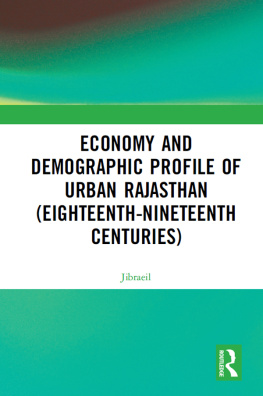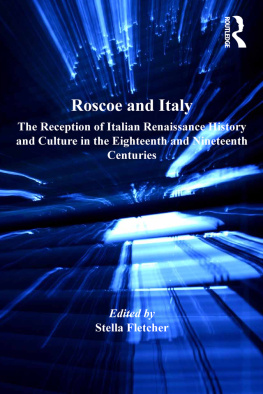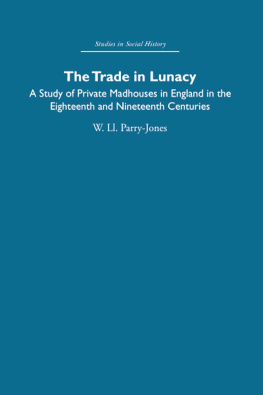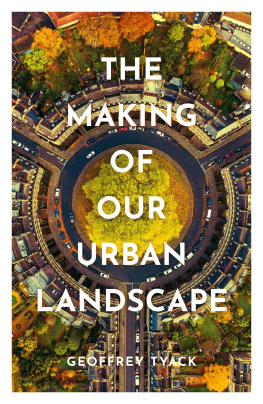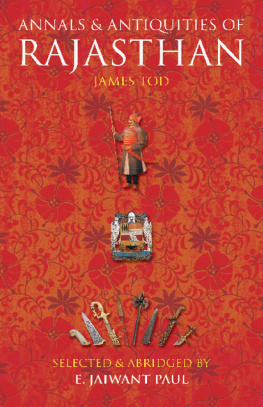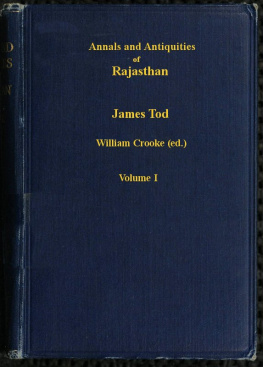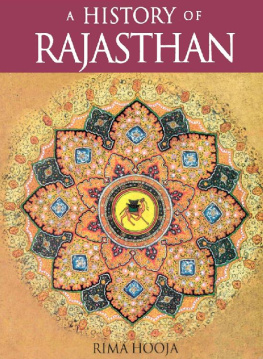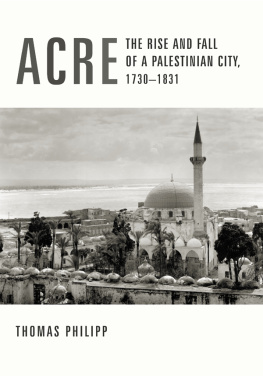ECONOMY AND DEMOGRAPHIC
PROFILE OF URBAN RAJASTHAN
(EIGHTEENTH-NINETEENTH CENTURIES)
The study is chiefly based on archival sources of different regions of Rajasthan. Different aspects of economy and human settlement are explored with the support of statistical details, charts and maps. I believe that this trend of division of periods and pattern of presentation will attract researchers in the future.
PROFESSOR G.S.L. DEVRA
Former Vice Chancellor, Kota University
Based on original sources, Dr. Jibraeils book Economy and Demographic Profile of Urban Rajasthan (Eighteenth-Nineteenth Centuries) reflects on demography in general and growth of Urban Centres in particular. The book will be of a great help to the researchers who are working on various trade routes, commodities as well as agricultural production in Rajasthan and other link states.
PROFESSOR SUNITA ZAIDI
Former Rhodes Fellow, Oxford,
Department of History and Culture, Jamia Millia Islamia, New Delhi
The volume deals with the inter-relations between agricultural production, agrarian trade, markets, towns and population of urban Rajasthan in the eighteenth-nineteenth centuries.
The factors for the growth of the agrarian markets are discussed in the light of the archival sources like arhsattas, toji-do-varkhi-baje-talke, sava bahis and khas-rukka-parwana bahis, of Amber (Jaipur), Hadauti (Kota), Bikaner and Marwar (Jodhpur) respectively. For this work since direct data on population count before 1881 is elusive the author has used house-count as well as different kinds of taxes (kholari, jhumpari and dhuan) while calculating the population of different urban centres. The question that how some of these markets gradually earned the status of towns is shown through available evidence.
This study also displays that how the higher receipts from sair-jihat (non-agrarian taxes) in various areas of Rajasthan, worked in the evolution of agrarian markets into qasbas.
This volume is essential reading for scholars of Agrarian History of Rajasthan in the colonial period.
Jibraeil is Assistant Professor at the Centre of Advanced Study, Department of History, Aligarh Muslim University, Aligarh.
Economy and Demographic
Profile of Urban Rajasthan
(Eighteenth-Nineteenth
Centuries)
JIBRAEIL
First published 2018
by Routledge
2 Park Square, Milton Park, Abingdon, Oxon OX14 4RN
and by Routledge
711 Third Avenue, New York, NY 10017
Routledge is an imprint of the Taylor & Francis Group, an informa business
2018 Jibraeil and Manohar Publishers & Distributors
The right of Jibraeil to be identified as author of this work has been asserted by him in accordance with sections 77 and 78 of the Copyright, Designs and Patents Act 1988.
All rights reserved. No part of this book may be reprinted or reproduced or utilised in any form or by any electronic, mechanical, or other means, now known or hereafter invented, including photocopying and recording, or in any information storage or retrieval system, without permission in writing from the publishers.
Trademark notice: Product or corporate names may be trademarks or registered trademarks, and are used only for identification and explanation without intent to infringe.
Print edition not for sale in South Asia (India, Sri Lanka, Nepal, Bangladesh, Afghanistan, Pakistan or Bhutan)
British Library Cataloguing in Publication Data
A catalogue record for this book is available from the British Library
Library of Congress Cataloging in Publication Data A catalog record for this book has been requested
ISBN: 978-1-138-59820-1 (hbk)
ISBN: 978-0-429-48649-4 (ebk)
Typeset in Agaramond 11/13
by Kohli Print, Delhi 110 051
To the memory of my parents
Janab Haji Hasan Raza and
Mrs Kitab-un-Nisha
Contents
Ain | Ain-i-Akbari |
IESHR | Indian Economic and Social History Review |
IHR | Indian Historical Review |
EI | Epigraphia Indica |
JRIHR | Journal of Rajasthan Institute of Historical Research |
Khyat | Muhnot Nainsi, Khyat |
PIHC | Proceedings of Indian History Congress |
PRHC | Proceedings of Rajasthan History Congress |
PUPHC | Proceedings of Uttar Pradesh History Congress |
RAS | Royal Asiatic Society |
RSA | Rajasthan State Archives |
RORI | Rajasthan Oriental Research Institute |
Tod | James Tod, Annals and Antiquities of Rajasthan |
VS | Vikram Samvat |
This book is a revised version of this authors doctoral thesis awarded at the Aligarh Muslim University. In the course of revision some new evidence has been examined which were even commented by the two experts of the thesis; one from Canada and second from India. One whole chapter on trading centres of Marwar (Pali and Nagaur) has been added. The present revised work was undertaken on the advice of my teacher and supervisor Prof. B.L. Bhadani and a few other scholars who have worked on Rajasthani sources, such as Prof. Dilbagh Singh and Prof. G.S.L. Devra, who suggested revising the thesis in the light of some other relevant archival records and with new additions because this is such a rare work, particularly on urban centres and population for the whole of Rajasthan.
To begin with, therefore, first I wish to express my deep sense of gratitude to Prof. B.L. Bhadani (Retired Professor, Coordinator and Chairperson, Centre of Advanced Study, Department of History, Aligarh Muslim University) for his keen interest and valuable suggestions during the entire period of the completion of this book. I am especially thankful to him for helping me for interpretation of important data-based documents.
I, lack words to express my debt of gratitude to such a great scholar of Rajasthan as Late Prof. S.P. Gupta who always provided his valuable time to discuss issues, related to my work such as dialects, tabulations and nature of documents during my research. In this context I am also grateful to Prof. Dilbagh Singh (Retired Professor, Head, Centre of Historical Studies, Jawaharlal Nehru University, New Delhi), Mr. Punam Chandra Joiya (Research Officer) and Mr. Mangtu Ram (In-charge of Kota records), Rajasthan State Archives, Bikaner.
I am greatly indebted to my esteemed well-wishers, particularly Prof. Ali Athar, Centre of Advanced Study, Department of History, Aligarh Muslim University), Prof. Abdul Matin (Department of Sociology, Aligarh Muslim University), Prof. Yaqub Ali Khan and Dr S. Bashir Hasan (Centre of Advanced Study, Department of History, Aligarh Muslim University), Mr Tahsinur Rahman Warsi (Associate Professor, Department of Architecture, Aligarh Muslim University), Prof. Jigar Mohammad (Department of History, University of Jammu & Kashmir), Prof. Ayub Ali Khan (Kakatia University, Warrangal), Prof. Inayat Ali Zaidi and Prof. Sunita Zaidi (Department of History and Culture, Jamia Millia Islamia University, New Delhi), Prof. S.P Vyas and Prof. K.L. Mathur (J.N.V. University, Jodhpur), Dr Firdos Anwar (Associate Professor, Department of History, Kirori Mal College, University of Delhi), Prof. Nishat Manzar and Prof. R.P Bahuguna (Department of History and Culture, Jamia Millia Islamia University, New Delhi), Dr Nasim Ahmad (General Physician, Aligarh), Dr Mayank Kumar (Associate Professor, Department of History, Satyawati College, University of Delhi), Dr Mukesh Kumar Singh (Associate Professor, Department of History, Shivaji College, University of Delhi), all of whom encouraged me to revise and publish my thesis in the form of a book. Equally, I am grateful to my other colleagues, well-wishers and friends in Aligarh Muslim University, Jamia Millia Islamia University, University of Delhi, Jawaharlal Nehru University and University of Rajasthan, from whom I received constant encouragement during the preparation of this book.



